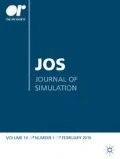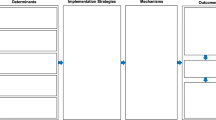Abstract
Health care systems are known to be complex and difficult to analyse. Unified Modelling Language (UML) tools have been extensively used to analyse complex systems in several domains, including health care. However, the utility of UML tools in the mapping of care processes has not been demonstrated. This paper reports on the findings of a project that employed UML tools to map the entire care process for patients presenting with symptoms of fractured neck of femur to an acute care hospital in the UK. We employed the UML activity diagram to capture the sequence and conditions of the progress of patients through care activities from a care-system perspective, use case to detail the function performed by each care activity depicted in the activity diagram, and use UML state diagram to capture the dynamic behaviour of patients by depicting states and transition specifications from a patient's perspective. We argue that UML tools can be beneficially employed in the mapping of care processes and to create an information library with the results of such mapping. We also argue that the process mapping method presented here can be used as a basis to develop requirements for simulation models of the flow of patients through the care process.



Similar content being viewed by others
References
Aggarwal V (2002). The application of the unified modeling language in object-oriented analysis of healthcare information systems. J Med Syst 26: 383–397.
Ambler S (2004). The Object Primer: Agile Modeling-Driven Development with UML 2.0. Cambridge University Press: Cambridge.
Berwick DM (2005). The John Eisenberg lecture: Health services research as a citizen in improvement. Health Serv Res 40: 317–336.
Checkland P (1999). Systems Thinking, Systems Practice: Includes a 30-Year Retrospective. John Wiley: Chichester.
Checkland P and Scholes J (1999). Soft Systems Methodology in Action. John Wiley: Chichester.
Cruz IA et al (2002). Modelling the hospital into the future with UML. Int J Healthc Tech Manag 4: 193–204.
Davies HTO and Davies R (1995). Simulating health systems: Modelling problems and software solutions. Eur J Opl Res 87: 35–44.
Department of Health (2005). Delivering Quality and Value: Focus on Fractured Neck of Femur; Primary Hip and Knee Replacement; Acute Stroke; Caesarean Section; Short Stay Emergency Care. Department of Health: London.
Goossen W et al (2004). Development of a provisional domain model for the nursing process for use within the Health Level 7 reference information model. J Am Med Inform Assoc 11: 186–194.
Hao Q and Shen W (2006). An agent-based simulation of a JIT material handling system. In: Shen W (ed). Information Technology for Balanced Manufacturing Systems, Springer: Boston, pp 67–78.
Harel D (1987). Statecharts: A visual formalism for complex systems. Sci Comput Program 8: 231–274.
Harel D and Politi M (1998). Modeling Reactive Systems with Statecharts: The STATEMATE Approach. McGraw-Hill: New York.
Hederman L, Smutek D, Wade V and Knape T (2002). Representing clinical guidelines in UMl: A comparative study. Stud Health Technol Inform 90: 471–477.
Hoffman KJ (1997). Demystifying mental health information needs through integrated definition (IDEF) activity and data modeling. Proc AMIA Annu Fall Symp 111–115.
Johnell O and Kanis JA (2004). An estimate of the worldwide prevalence, mortality and disability associated with hip fracture. Osteoporosis Int 15: 897–902.
Jun GCT (2007). Design for Patient Safety: A Systematic Evaluation of Process Modelling Approaches for Healthcare System Safety Improvement. PhD Thesis, Department of Engineering, University of Cambridge, Cambridge.
Kalli S et al (1992). Inform: Conceptual modelling of intensive care information systems. Int J Clin Monit Comput 9: 85–94.
Kotiadis K (2007). Using soft systems methodology to determine the simulation study objectives. J Simul 1: 215–222.
Lenz R and Kuhn KA (2004). Towards a continuous evolution and adaptation of information systems in healthcare. Int J Med Inform 73: 75–89.
Lunn K, Sixsmith A, Lindsay A and Vaarama M (2003). Traceability in requirements through process modelling, applied to social care applications. Inf Softw Technol 45: 1045–1052.
Lyalin D and Williams W (2005). Modeling cancer registration processes with an enhanced activity diagram. Methods Inf Med 44: 11–13.
Mazur L and Chen SJ (2008). Understanding and reducing the medication delivery waste via systems mapping and analysis. Health Care Manag Sci 11: 55–65.
Mehta NY, Haluck RS, Frecker MI and Snyder AJ (2002). Sequence and task analysis of instrument use in common laparoscopic procedures. Surg Endosc 16: 280–285.
Object Management Group (2005). Unified Modeling Language: Superstructure. Version 2.0. OMG Inc.
Pohjonen H et al (1994). Quality assurance of the bedside chest radiography process. Acta Radiol 35: 235–243.
Roberts SE and Goldacre MJ (2003). Time trends and demography of mortality after fractured neck of femur in an English population, 1968–98: Database study. BMJ 327: 771–775.
Robinson S (2004). Simulation: The practice of Model Development and Use. John Wiley & Sons: Chichester, NJ.
Saboor S, Ammenwerth E, Wurz M and Chimiak-Opoka J (2005). Med flow—Improving modelling and assessment of clinical processes. Stud Health Technol Inform 116: 521–526.
Scottish Intercollegiate Guidelines Network (2002). Prevention and Management of Hip Fracture in Older People. A National Clinical Guideline. SIGN Executive: Edinburgh.
Sobolev B, Harel D, Vasilakis C and Levy AR (2008). Using the statecharts paradigm for simulation of patient flow in surgical care. Health Care Manag Sci 11: 79–86.
Vasilakis C, Lecznarowicz D and Lee C (2008). Application of Unified Modelling Language (UML) to the modelling of health care systems: An introduction and literature survey. Int J Healthcare Inf Syst Inform 3: 39–52.
Vasilakis C, Sobolev B, Kuramoto L and Levy AR (2007). A simulation study of scheduling clinic appointments in surgical care: Individual-surgeon versuspooled lists. J Oper Res Soc 58: 202–211.
Young T (2005). An agenda for healthcare and information simulation. Health Care Manag Sci 8: 189–196.
Acknowledgements
This research was supported by an award from the Strategic Promotion of Ageing Research Capacity (SPARC) initiative. The authors acknowledge the support they received from the Harrow School of Computer Science, University of Westminster, as well as the generous advice they received from Prof. Peter Millard, Prof. Peter Lansley of SPARC, and Dr Elia El-Darzi. The following individuals provided us with their expert knowledge in understanding the care process: Inge Jensen, Sarah Joseph, Sarah Loades, Eva van Lock, Dr Evangelos Mangos, Prof Peter Millard, Susie Peerless, Mr Palanisamy Ramesh, Angela Roberts, and Carolyn Wilkinson.
Author information
Authors and Affiliations
Corresponding author
Rights and permissions
About this article
Cite this article
Vasilakis, C., Lecznarowicz, D. & Lee, C. Developing model requirements for patient flow simulation studies using the Unified Modelling Language (UML). J Simulation 3, 141–149 (2009). https://doi.org/10.1057/jos.2009.3
Received:
Accepted:
Published:
Issue Date:
DOI: https://doi.org/10.1057/jos.2009.3




